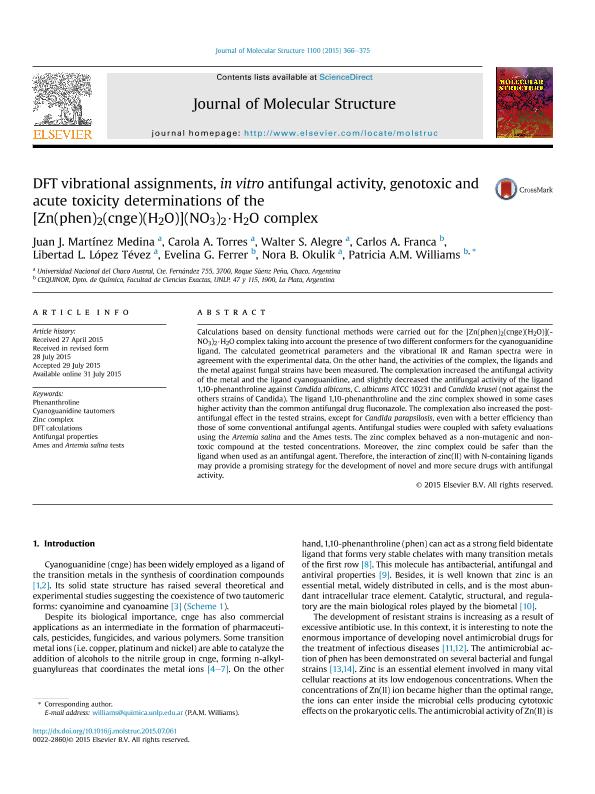Artículo
DFT vibrational assignments, in vitro antifungal activity, genotoxic and acute toxicity determinations of the [Zn(phen)2(cnge)(H2O)](NO3)2·H2O complex
Martínez Medina, Juan José ; Torres, Carola Analía
; Torres, Carola Analía ; Alegre, Walter S.; Franca, Carlos Alberto; López Tévez, Libertad Leonor; Ferrer, Evelina Gloria
; Alegre, Walter S.; Franca, Carlos Alberto; López Tévez, Libertad Leonor; Ferrer, Evelina Gloria ; Okulik, Nora Beatriz
; Okulik, Nora Beatriz ; Williams, Patricia Ana María
; Williams, Patricia Ana María
 ; Torres, Carola Analía
; Torres, Carola Analía ; Alegre, Walter S.; Franca, Carlos Alberto; López Tévez, Libertad Leonor; Ferrer, Evelina Gloria
; Alegre, Walter S.; Franca, Carlos Alberto; López Tévez, Libertad Leonor; Ferrer, Evelina Gloria ; Okulik, Nora Beatriz
; Okulik, Nora Beatriz ; Williams, Patricia Ana María
; Williams, Patricia Ana María
Fecha de publicación:
08/2015
Editorial:
Elsevier Science
Revista:
Journal of Molecular Structure
ISSN:
0022-2860
e-ISSN:
1872-8014
Idioma:
Inglés
Tipo de recurso:
Artículo publicado
Clasificación temática:
Resumen
Calculations based on density functional methods were carried out for the [Zn(phen)2(cnge)(H2O)](NO3)2·H2O complex taking into account the presence of two different conformers for the cyanoguanidine ligand. The calculated geometrical parameters and the vibrational IR and Raman spectra were in agreement with the experimental data. On the other hand, the activities of the complex, the ligands and the metal against fungal strains have been measured. The complexation increased the antifungal activity of the metal and the ligand cyanoguanidine, and slightly decreased the antifungal activity of the ligand 1,10-phenanthroline against Candida albicans, C. albicans ATCC 10231 and Candida krusei (not against the others strains of Candida). The ligand 1,10-phenanthroline and the zinc complex showed in some cases higher activity than the common antifungal drug fluconazole. The complexation also increased the post-antifungal effect in the tested strains, except for Candida parapsilosis, even with a better efficiency than those of some conventional antifungal agents. Antifungal studies were coupled with safety evaluations using the Artemia salina and the Ames tests. The zinc complex behaved as a non-mutagenic and non-toxic compound at the tested concentrations. Moreover, the zinc complex could be safer than the ligand when used as an antifungal agent. Therefore, the interaction of zinc(II) with N-containing ligands may provide a promising strategy for the development of novel and more secure drugs with antifungal activity.
Archivos asociados
Licencia
Identificadores
Colecciones
Articulos(CCT - NORDESTE)
Articulos de CTRO.CIENTIFICO TECNOL.CONICET - NORDESTE
Articulos de CTRO.CIENTIFICO TECNOL.CONICET - NORDESTE
Citación
Martínez Medina, Juan José; Torres, Carola Analía; Alegre, Walter S.; Franca, Carlos Alberto; López Tévez, Libertad Leonor; et al.; DFT vibrational assignments, in vitro antifungal activity, genotoxic and acute toxicity determinations of the [Zn(phen)2(cnge)(H2O)](NO3)2·H2O complex; Elsevier Science; Journal of Molecular Structure; 1100; 8-2015; 366-375
Compartir
Altmétricas



